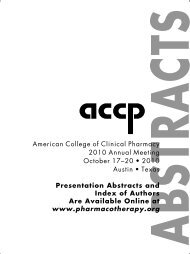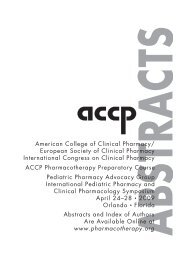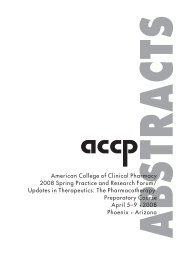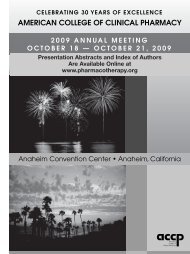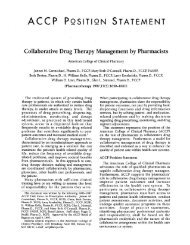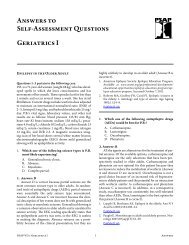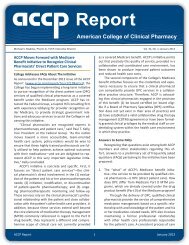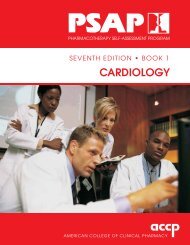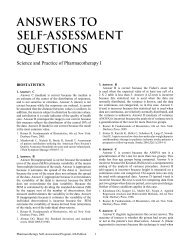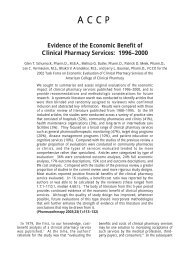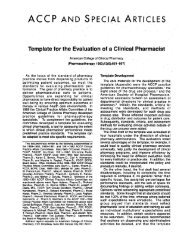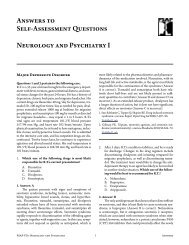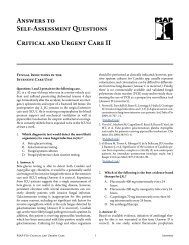Answers to Self-Assessment Questions - ACCP
Answers to Self-Assessment Questions - ACCP
Answers to Self-Assessment Questions - ACCP
Create successful ePaper yourself
Turn your PDF publications into a flip-book with our unique Google optimized e-Paper software.
during continuous venovenous hemodiafiltration in critically<br />
ill patients. Am J Clin Nutr 2004;80:410–6.<br />
2. S<strong>to</strong>ry DA, Ronco C, Bellomo R. Trace element and vitamin<br />
concentrations and losses in critically ill patients treated<br />
with continuous venovenous hemofiltration. Crit Care Med<br />
1999;27:220–3.<br />
18. Answer: D<br />
W.G.’s serum glucose concentration has been consistently<br />
elevated. The best approach for managing his hyperglycemia<br />
would be <strong>to</strong> start regular insulin by continuous intravenous<br />
infusion (Answer D); thus Answer D is correct. Using a<br />
sliding scale regimen of insulin aspart (Answer B) would<br />
be a reactive approach <strong>to</strong> hyperglycemia as opposed <strong>to</strong><br />
a proactive approach with the insulin infusion. Sliding<br />
scale insulin regimens are no longer widely used in ICUs.<br />
Although adding regular insulin <strong>to</strong> the PN formulation<br />
(Answer C) is more convenient for the nursing staff, it is<br />
not ideal for a patient like W.G. who is receiving CRRT.<br />
If insulin is in the PN formulation and CRRT is s<strong>to</strong>pped<br />
for any reason (e.g., because of filter clotting), the glucose<br />
delivery from the dialysis and replacement solutions will<br />
abruptly s<strong>to</strong>p, creating the potential for hypoglycemia unless<br />
the PN formulation is also s<strong>to</strong>pped. Similarly, administering<br />
insulin glargine subcutaneously every night (Answer A)<br />
would place the patient at risk of hypoglycemia in the event<br />
that any glucose source is discontinued.<br />
1. Wooley JA, Btaiche IF, Good KL. Metabolic and nutritional<br />
aspects of acute renal failure in critically ill patients requiring<br />
continuous renal replacement therapy. Nutr Clin Pract<br />
2005;20:176–91.<br />
2. Scheinkestel CD, Adams F, Mahony L, Bailey M, Davies<br />
AR, Nyulasi I, et al. Impact of increasing parenteral protein<br />
loads on amino acid levels and balance in critically ill anuric<br />
patients on continuous renal replacement therapy. Nutrition<br />
2003;19:733–40.<br />
19. Answer: B<br />
Various formulas are available for calculating nitrogen<br />
balance. Standard formulas have been revised <strong>to</strong> be used<br />
in patients receiving CRRT. W.G.’s nitrogen balance is<br />
negative 6.5 (-6.5) g of nitrogen (Answer B). This value can<br />
be calculated using the following equation:<br />
Nitrogen balance (g/day) = nitrogen intake (g/day) −<br />
nitrogen loss (g/day). In patients receiving CRRT, nitrogen<br />
loss (g/day) = effluent urea nitrogen loss (g/day) + amino<br />
acid losses across CRRT membrane (g/day) + urine urea<br />
nitrogen [UUN] (g/day) + insensible losses (2–4 g/day).<br />
W.G. is receiving 175 g of protein per day through his<br />
enteral formulation and additional protein supplementation.<br />
This intake provides 28 g of nitrogen per day (175 g of<br />
protein/6.25 g of protein per gram of nitrogen). The effluent<br />
urea nitrogen loss (grams per day) = <strong>to</strong>tal volume of<br />
replacement fluid (liters) + dialysate fluid (liters) + volume<br />
(liters) of parenteral volume removed from the patient over<br />
24 hours × the average urea nitrogen from the effluent<br />
sample (51 mg/dL). Convert 51 mg/dL <strong>to</strong> grams per liter<br />
by multiplying by 0.01 = 0.51 g of nitrogen per liter. Total<br />
replacement fluid plus dialysate fluid plus parenteral volume<br />
removed = 36,000 mL + 12,000 mL + 8,000 mL = 56,000<br />
mL = 56 L. Therefore, 56 L × 0.51 g of N per liter = 28.5<br />
g of nitrogen is lost as dialysate urea nitrogen. Dialysate<br />
plus replacement fluids are infusing at 2 L/hour; therefore,<br />
amino acid losses across the CRRT membrane = 2 g of N<br />
per day. Because W.G. is anuric, the UUN is omitted from<br />
the calculation. Adding 4 g of nitrogen for insensible losses<br />
gives a <strong>to</strong>tal of 34.5 g of nitrogen out. Nitrogen balance = 28<br />
g of nitrogen in – 34.5 g of nitrogen out = − 6.5 g of nitrogen.<br />
Answer A [negative 9 (−9) g of N], Answer C [negative 1.5<br />
(−1.5) g of N], and Answer D [positive 1 (+1) g of N] are<br />
incorrect based on the above calculations.<br />
1. Liu KD, Stralovich-Romani A, Cher<strong>to</strong>w GM. Nutrition support<br />
for adult patients with acute renal failure. In: Merritt R, ed. The<br />
A.S.P.E.N. Nutrition Support Practice Manual, 2nd ed. Silver<br />
Spring, MD: American Society for Parenteral and Enteral<br />
Nutrition, 2005:281–6.<br />
2. Manning EM, Shenkin A. Nutritional assessment in the<br />
critically ill. Crit Care Clin 1995;11:603–34.<br />
20. Answer: D<br />
W.G. has been converted from intermittent hemodialysis<br />
<strong>to</strong> CRRT. A high-nitrogen feeding formulation (Answer<br />
D) should be initiated because it will meet the high protein<br />
needs of this patient receiving CRRT. Also, additional<br />
protein supplementation will be needed. A low-electrolyte,<br />
renal disease–specific enteral formulation (Answer A) is not<br />
needed at this time because the low-electrolyte composition<br />
of these products is not needed during CRRT. Immuneenhancing<br />
feeding formulations (Answer B) may have a<br />
role, but currently neither clinical nor literature support is<br />
available <strong>to</strong> justify the use of these expensive formulations<br />
in patients receiving CRRT. Calorie-dense feeding<br />
formulations (Answer C) often lead <strong>to</strong> gastroparesis, which<br />
is common in patients such as W.G. who have diabetes<br />
mellitus and are receiving CRRT; thus Answer C is not the<br />
best answer.<br />
1. Wooley JA, Btaiche IF, Good KL. Metabolic and nutritional<br />
aspects of acute renal failure in critically ill patients requiring<br />
continuous renal replacement therapy. Nutr Clin Pract<br />
2005;20:176–91.<br />
2. Kapadia FN, Bhojani K, Shah B. Special issues in the<br />
patient with renal failure. Crit Care Clin 2003;19:233–5<br />
Home Parenteral Nutrition<br />
21. Answer: D<br />
A 70-year-old man was hospitalized with pancreatitis<br />
associated with biliary tract disease. Fifteen days after<br />
admission, after undergoing cholecystec<strong>to</strong>my, he is unable<br />
<strong>to</strong> <strong>to</strong>lerate oral nutrition. Two pancreatic pseudocysts were<br />
identified by ultrasound examination. The best nutrition<br />
support regimen for home nutrition support for this patient<br />
is Answer D (enteral feeding with the tip of the feeding<br />
tube located past the ligament of Treitz). There are several<br />
studies demonstrating that a nasojejunal feeding tube<br />
with the tip past the ligament of Treitz provides effective<br />
nutrition without pancreatic stimulation, which is the cause<br />
of the pain when oral feedings are attempted. Although<br />
difficult, this type of feeding can be done at home and, if<br />
it is <strong>to</strong>lerated, saves the high cost and complication rate of<br />
home PN. Answer A (PN though a central venous access<br />
device [CVAD]) is incorrect because PN is not indicated<br />
Pharmacotherapy <strong>Self</strong>-<strong>Assessment</strong> Program, 6th Edition 39 Gastroenterology and Nutrition <strong>Answers</strong>



